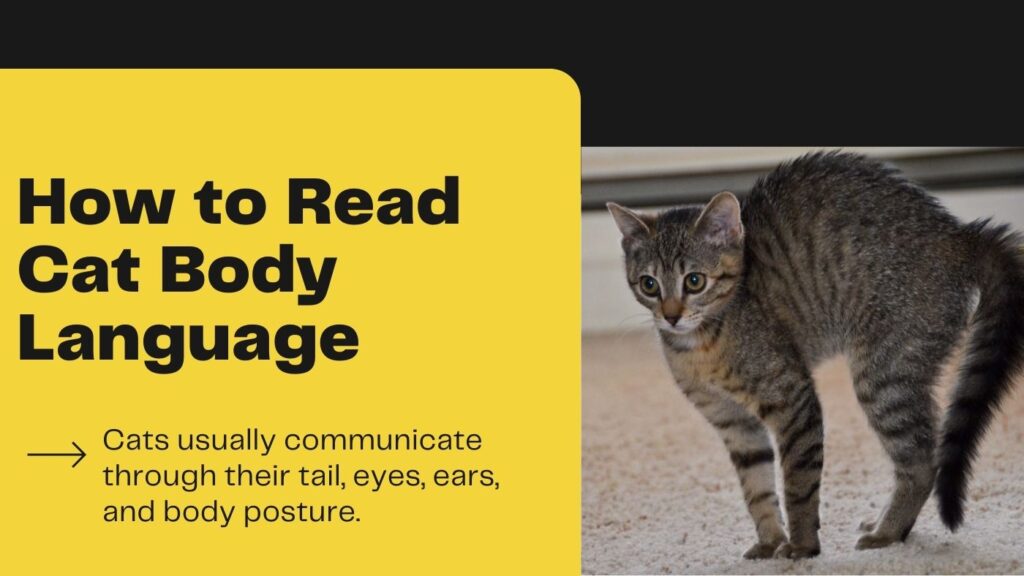Cats mainly express their emotion through non-verbal language. It is very beneficial as a cat owner to be able to read your cat’s body language and understand what they are feeling. Below are several steps to help you learn how to read your cat’s body language.
How to read cats body language by body part:
Cats primarily communicate through their tail, eyes, ears, and body posture. Read on to see how to read a cat’s body language.
Cats can be easy to understand through their body communication mechanisms. Even though non-verbal, their emotions and behaviors can be easy to decode if you know what to look for. Below are some of cat’s body parts that are used the most to communicate.
Tail
You should pay close attention to a cat’s tail as it closely reflects its mood. For example, if your cat repeatedly hits their tail against the floor, they are likely annoyed or agitated. If your cat’s tail sticks straights up and moves around, it usually means they are happy or excited.
Your cat might also wrap their cat around your leg to greet you.
Eyes
Just like humans, a cat’s eye changes with its emotions. If a cat wants to assert dominance, they will intently stare without blinking. If a cat has squinted eyes and opens their mouth, they might be ready to lunge out in aggression.
Ears
If you play close attention to your cat, you will likely see that they frequently change the posture of their ears depending how they feel. If your cat’s ears stick straight up, they are likely focused on something. If your cat is frightened, they will likely stick their ears back.
Body Posture
If your cat lies down and expose their belly, it means they feel safe. If your cat is crouched down with their hind legs sticking up, it might mean that your cat will pounce soon. However, this doesn’t always mean your cat feels aggressive. Your cat could just be in a playful mood.
How Cats Express Emotions
Cats use their body parts to express their emotions. You will understand your cat better know when to intervene by learning their habits. Additionally, learning its postures may help you protect it from an imminent threat. You will know whether it’s just anxiety or a serious threat.
How to Tell if a Cat is Relaxed
There are many ways a cat will show that it is relaxed. For example, it might lay down and keep its paws under the body. As mentioned earlier, they might also expose their belly if they feel safe and relaxed. Cats will also close their eyes and rest when they feel relaxed and safe.
How to Tell if a Cat is Alert
A cat that is alert will likely stick it ears up or slightly forward. They will also likely fix their eyes on whatever they are focused on.
How to Tell if a Cat is Tense
A cat that is tense might try to hide under something. They may also start to meow or make other noises. A cat that is tensed up will usually have a very stiff body and not move. They will also likely have a fast heart rate and they might stick out their whiskers.
A tense cat will probably keep their tail close to their body.
How to Tell if a Cat is Anxious
An anxious cat will likely show similar signs to a tense cat. They might also start to hide in places, and meow a lot. Anxious cats might also start scratching random objects. Your cat’s pupils might also become dilated if they are anxious.
How to Tell if a Cat is Fearful
A fearful cat is often motionless, alert, crouched, and the body will likely stay near the ground with their feet under their body. They do this so they can pounce or run away quickly.
A scared cat might have the hair on their back start to stick up. Depending on the source of fear, the cat may start to shake. A fearful cat might lash out with their claws to protect themselves.
A cat is usually terrified when their is an animal nearby that might attack it. Animals that terrify the cat include snakes, dogs, and raccoons. A terrified cat is motionless, alert, and usually keeps its eyes on the enemy.
Cats that are scared will might also arch their back. A scared cat will likely start to hiss or meow. Your cat’s pupils will also become dilated when they are scared of something.
Conclusion
Cats use postures, sounds, and other non-verbal signals to communicate and portray their emotions. Understanding these postures is important and may help protect your pet from a possible threat. Also, if you have several pets in your house, learning the cat’s posture may help you know if they get along.
Although cats are fun to be around, they have their fair share of problems like down syndrome and cancer. However, that shouldn’t hinder you from owning one.

